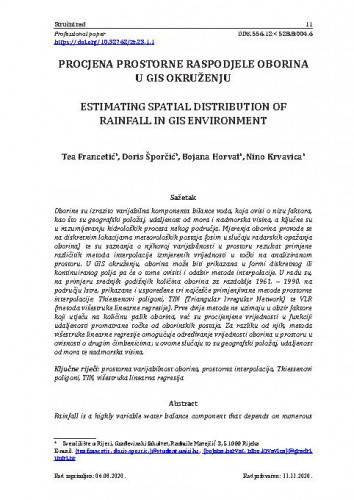Oborine su izrazito varijabilna komponenta bilance voda, koja ovisi o nizu faktora, kao što su geografski položaj, udaljenost od mora i nadmorska visina, a ključne su u razumijevanju hidroloških procesa nekog područja. Mjerenja oborina provode se na diskretnim lokacijama meteoroloških postaja (osim u slučaju radarskih opažanja oborina) te su saznanja o njihovoj varijabilnosti u prostoru rezultat primjene različitih metoda interpolacije izmjerenih vrijednosti u točki na analiziranom prostoru. U GIS okruženju, oborina može biti prikazana u formi diskretnog ili kontinuiranog polja pa će o tome ovisiti i odabir metode interpolacije. U radu su, na primjeru srednjih godišnjih količina oborina za razdoblje 1961. – 1990. na području Istre, prikazane i uspoređene tri najčešće primjenjivane metode prostorne interpolacije: Thiessenovi poligoni, TIN (Triangular Irregular Network) te VLR (metoda višestruke linearne regresije). Prve dvije metode ne uzimaju u obzir faktore koji utječu na količinu palih oborina, već su procijenjene vrijednosti u funkciji udaljenosti promatrane točke od oborinskih postaja. Za razliku od njih, metoda višestruke linearne regresije omogućuje određivanje vrijednosti oborina u prostoru u ovisnosti o drugim čimbenicima; u ovome slučaju to su geografski položaj, udaljenost od mora te nadmorska visina.; Rainfall is a highly variable water balance component that depends on numerous factors such as geographical location, distance from the sea, and elevation. Rainfall is crucial in understanding the hydrological processes in the given catchment. Rainfall measurements are performed at discrete locations at meteorological stations (except in the case of radar measurements). The knowledge of their spatial and temporal variability is the result of applying different methods of interpolation of measured values inside a given area. In a GIS environment, rainfall can be displayed in the form of a discrete or continuous field. Therefore, the choice of the interpolation method depends on the requirements for the type of the result. In this paper, three widely used methods of spatial interpolation are presented and compared to an example of estimating the average annual rainfall in Istria for the period 1961 – 1990. Namely, the following three interpolation methods are considered: Thiessen polygons, TIN (Triangular Irregular Network), and VLR (multiple linear regression method). The first two methods do not consider the factors that affect the amount of rainfall; they only estimate values as a function of the distance of the observed point from the rainfall gauges. In contrast, the method of multiple linear regression determines the spatial distribution of the rainfall from other factors, in this case, the geographical location, distance from the sea, and elevation.
Sažetak

 Zbornik radova : 23,1(2020) / Građevinski fakultet Sveučilišta u Rijeci ; glavna i odgovorna urednica Iva Mrak
Zbornik radova : 23,1(2020) / Građevinski fakultet Sveučilišta u Rijeci ; glavna i odgovorna urednica Iva Mrak